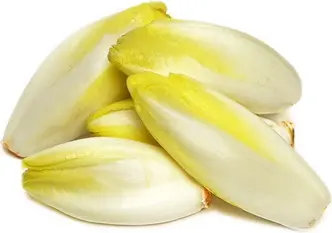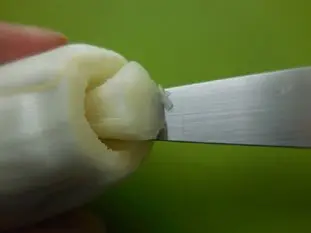This site uses only a few technical cookies necessary for its operation. By continuing to browse, you accept their use.
To find out more...
To find out more...
The bitterness of endives

As I write these lines, we are entering the endive season, and if you like it, it's time to enjoy it, if possible with your local producers.
Endive is good, but the reproach that is often made of it, and children in particular, is: "It's bitter!
And it is (somewhat) true of course, endives have a little bitterness in them that contributes to their charm, and that we may not like. Bitterness moreover which is accentuated with cooking, it is discrete on a raw endive, a little stronger on a cooked one, and very marked on one too cooked.
So if you want to eat cooked endive that is not too bitter, is it possible?
Endive is good, but the reproach that is often made of it, and children in particular, is: "It's bitter!
And it is (somewhat) true of course, endives have a little bitterness in them that contributes to their charm, and that we may not like. Bitterness moreover which is accentuated with cooking, it is discrete on a raw endive, a little stronger on a cooked one, and very marked on one too cooked.
So if you want to eat cooked endive that is not too bitter, is it possible?
14 K 4.9/5 (16 reviews)
Keywords for this post:EndivesBitternessChildrenLast modified on: February 9th 2019
The bitterness of endives
Yes, and there is a trick to this, a trick that consists of removing, and discarding, the most bitter part of the endive, the heart, before using it.
This part, shaped like a cone, is at the base of the endive and can be removed with a small sharp knife like this:
Once this is done, use the endive as normal, but keep in mind to cook it for as little time as possible, it is not a vegetable that is meant to be cooked, but to be stopped cooking as soon as it is tender.
Another way to reduce this bitterness is to blanch them. If you have a recipe for cooked endives, for example endives au gratin, do not hesitate to blanch them for 1 or 2 minutes in boiling salted water, then drain them very carefully before using them normally.
Well, you have to be honest, you will reduce the bitterness with all this, but not make it disappear, the bitterness is part of the taste of endive, there is a big work of seduction to do with children to get them to eat it...
If you are in this moment, I suggest you to start with an endive salad with walnuts (raw then) finely sliced with a walnut oil dressing, it is a very good, and very progressive beginning, for a discovery of endive.
To sum up: For less bitter endives: 1) Remove the core 2) Cook as little as possible.
This part, shaped like a cone, is at the base of the endive and can be removed with a small sharp knife like this:

Once this is done, use the endive as normal, but keep in mind to cook it for as little time as possible, it is not a vegetable that is meant to be cooked, but to be stopped cooking as soon as it is tender.
Another way to reduce this bitterness is to blanch them. If you have a recipe for cooked endives, for example endives au gratin, do not hesitate to blanch them for 1 or 2 minutes in boiling salted water, then drain them very carefully before using them normally.
Well, you have to be honest, you will reduce the bitterness with all this, but not make it disappear, the bitterness is part of the taste of endive, there is a big work of seduction to do with children to get them to eat it...
If you are in this moment, I suggest you to start with an endive salad with walnuts (raw then) finely sliced with a walnut oil dressing, it is a very good, and very progressive beginning, for a discovery of endive.
To sum up: For less bitter endives: 1) Remove the core 2) Cook as little as possible.
Lasts posts
Butter vs. grease
We often read in a recipe where a pastry is put into a mould that, just before pouring, the mould should be buttered or greased. But what's the difference between these 2 terms?December 1st 20259685
Getting out of the fridge early
Very often when you're cooking, you need to take food or preparations out of the fridge, to use them in the recipe in progress. There's nothing tricky about this: you just take them out of the fridge and use them, usually immediately, in the recipe. But is this really a good method?November 24th 20251,1015
Who's making the croissants?
When you look at a bakery from the outside, you naturally think that in the bakery, the bakers make the bread, and in the laboratory, the pastry chefs make the cakes. It's very often like that, with each of these professions having quite different ways of working, but sometimes there's also one...November 23th 2025995
Oven height
When we put a dish or cake in the oven, we naturally tend to put it on the middle shelf, and that's what we usually do. But in some cases, this position and height can be a little tricky, so let's find out why.October 8th 20252,7175
The importance of sieving
In recipes that use a fine powder (flour, powdered sugar, etc.), you'll often see the advice to sift before using it. To sift is to pass the powder in question through a sieve (a very fine strainer) before incorporating it into your recipe. It's often advice, but is it really useful?September 3rd 20257,5263
Other pages you may also like
What is the difference between bakery and patisserie?
This is a question that you may well have asked yourself and which I will attempt to answer. In France the two trades of "boulangerie" (bakery) and "pâtisserie" (patisserie and confectionery) have always been quite distinct, but where exactly do the boundaries lie? .February 7th 2017134 K 14.1
The return of the "Norman hole"
You maybe know the "trou normand", this old gastronomic custom typically French which consists in taking a (small) glass of calvados, generally between the last course and the dessert? It's something that seems a bit anachronistic nowadays, having a glass of an alcohol of more than 60° in the...December 18th 202115 K4.8
The window-pane test in bread-making
The home bread-makers often ask themselves “Have I kneaded my dough long enough?” . A good question, as dough that is insufficiently kneaded will not rise properly or will fall flat when the top is slashed, which is very frustrating. To know when the dough is ready, one can rely on the length...June 16th 202196 K 23.9
Candied fruits: don't get ripped off
Do you like candied fruit? You might like to nibble a handful or add it to a recipe, like a classic fruit cake or delicious Italian specialities like panettone or sicilian epiphany pie.June 21th 201767 K 24.2
For well opened (puffed) cakes
It's always nice to have a well puffed up cake after baking, not only will it taste good but it looks great too. Let's see how to get this beautiful shape almost every time.January 23th 201935 K4.2
Post a comment or question
Follow this page
If you are interested in this page, you can "follow" it, by entering your email address here. You will then receive a notification immediately each time the page is modified or a new comment is added. Please note that you will need to confirm this following.
Note: We'll never share your e-mail address with anyone else.
Alternatively: you can subscribe to the mailing list of cooling-ez.com , you will receive a e-mail for each new recipe published on the site.









